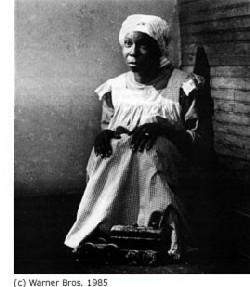The Migration of
the Story
Re: Telling the Story
- The Color Purple
“I belong to a people, heart and soul, who do not trust mirrors.
Not those, in any case, in which we ourselves appear.”
-Alice Walker
Criticisms of The
Color Purple
 When
The Color Purple was published
in 1982, many critics recognized ingenuity of the novel. At the
same time however, Alice Walker and The
Color Purple were also attacked (largely by Black critics) who
were insulted by Walker’s apparently damaging portrayal of African-Americans.
When
The Color Purple was published
in 1982, many critics recognized ingenuity of the novel. At the
same time however, Alice Walker and The
Color Purple were also attacked (largely by Black critics) who
were insulted by Walker’s apparently damaging portrayal of African-Americans.
The critics who criticized The Color Purple believed that it hurt relationships between Black men and women. But what these critics seemed most concerned with was the portrayal of Black men in the novel.
Alice Walker’s detractors claimed that the representations of Black men in The Color Purple were stereotypical, and that there was an overemphasis of Black male brutality within the novel. The novel was sometimes dismissed as having a “feminist bias” that saw men as primarily abusive, and it was also criticized for viewing men through the Black female gaze. It has been said that Alice Walker’s ideas of equality and tolerance were “harmful,” and that the success she received from The Color Purple was at the expense of Black male writers. Because of such hurtful attacks by her own people, Alice Walker eventually took temporary exile in Mexico.
In her book, The Same River Twice, Alice Walker revisits the early years of The Color Purple and addresses some of the misguided criticism that she received. In reading her reflections on writing the book, it becomes apparent that she is unapologetic for characters in the novel. For the record, she writes, “from infancy I have relied on the fiercely sweet spirits of Black men; and this is abundantly clear in my work.” She also notes,
"I was not guided or accompanied by the spirits of Black men who embarrass and oppress us . . . for whom the humiliation and subjugation of women is the preferred expression of masculinity. I feel no regret for this. I am not interested . . . in fulfilling the expectations of others".
While reading The Same
River Twice, it is upsetting to have to acknowledge the truth
in Walker’s personal views on her earlier detractors. She says,
“it was a rare critic who showed any compassion for, or even noted,
the suffering of the women and children explored in the book.” Despite
the struggles explored within the pages of The Color Purple,
they drew little attention.
Return Home

|
Disclaimer © 2003 - 2004 by class of SOSC 4319 at York University |